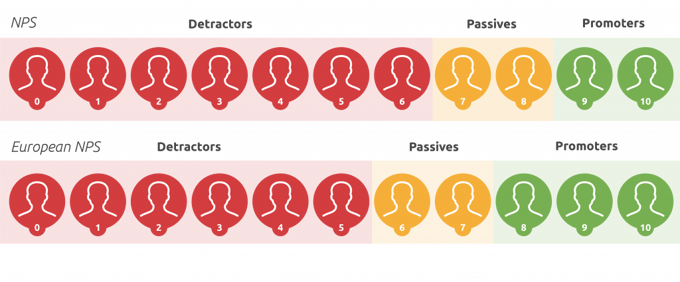The popularity of Net Promoter Scores is undeniable. Nowadays, almost every company in the world measures its NPS. But the standards of NPS do not necessarily fit every culture. In general, companies in Europe score a lower NPS than companies in America. Why is this?
The popularity of Net Promoter Scores is undeniable. Nowadays, almost every company in the world measures its NPS. But the standards of NPS do not necessarily fit every culture. In general, companies in Europe score a lower NPS than companies in America. Why is this?
Cultural differences in scoring nature
It mainly has to do with the 'scoring nature' of different countries and cultures. When Americans are asked to rate something on a scale of 0 to 10, they are far more likely to give more extreme answers compared to Europeans. This is deeply rooted in their culture. For example, American children are expected to get al A's (=10) in high school. In Europe, students hardly can ever get a 10 and this is not an expectation. We are rather proud of an 8 and nowadays, we say that 'a 6 is also a pass' (or: the 6s culture).
In addition, in surveys where the question is asked: "What can we do for a 9 or a 10?", we see answers such as: "Nothing, I think your service is fine!" or "I only recently became a customer and cannot yet give a 10". So, there was nothing wrong with the contact moment or the process but giving a 10 is simply something very 'big' to do in our culture and only happens in extreme cases.
An 8 is good enough
In the Netherlands, we are used to the fact that an 8 simply means 'good'. A good mark to give and a good mark to receive. But is an 8 responding to the NPS question really good enough? KIRC foundation investigated this with data.
The NPS is intended to give you an indication of whether a customer will make a repeat purchase, based on the proposition: if they would recommend you to others, they themselves will remain loyal to you. According to KIRC's research, which they presented at the KSF annual conference on the 20th of November 2018, there is little to no difference in the number of repeat purchases between customers who give you an 8 or a 9 or even a 10.
This means that you can also consider customers who give you an 8 to be loyal. However, the well-known yardstick NPS indicates that an 8 is a passive, and you will only be a promoter from a 9 or a 10.
A European standard
Therefore, there is a European NPS for our 'critical' and 'down-to-earth' cultures, whereby 8, 9 and 10 are seen as promoters and 6 and 7 as passives (after all, a 6 is simply a pass). In this way, the yardstick fits much better with the culture of Europeans and you also gain insights that fit better with this.

Source: Handboek E-commerce






